Annual Meeting Roundup
Highlights and observations from the 2010 SIAM Annual Meeting & the SIAM Conference on the Life Sciences
July 12-16, 2010, Pittsburgh, PA
Watch an overview video of the 2010 Annual Meeting.
The Geometry of Music:
What could be a better medium to communicate math to the public than the universal language of music? Ever since Pythagoras used numerical terms to express intervals between notes and derived musical tones from geometrical patterns, mathematicians have linked music to numbers. At the SIAM Annual Meeting’s I. E. Block Lectur—designed to encourage public appreciation of math—Dr. Dmitri Tymoczko made the connection with help from multimedia graphics and compositions by Chopin, Mozart and Schubert. Watch a video overview of Dr. Tymoczko’s lecture: http://www.youtube.com/watch?v=2A4Tt62pWaI
The full presentation can be accessed here.
Professional Development Evening:
The Professional Development Evening at the SIAM Annual Meeting focused on various aspects of obtaining a job for individuals transitioning from graduate school or postdoctoral positions. In the first session, attendees heard perspectives on different career choices in academia, industry, and government. In the second session, they were given an opportunity to network with one another and to discuss various career options. In the third session, panelists from academia, industry, and government shared their tips on jump starting a career.
Funding Agencies Panel:
Representatives from various funding agencies discussed recent trends and future plans for funding research in computational and applied mathematics, and entertained questions from the audience at the Funding Agencies Panel at SIAM's Annual Meeting. Here is a video recap: http://www.youtube.com/watch?v=Nmrnee9owaQ
The Dynamics of Obesity
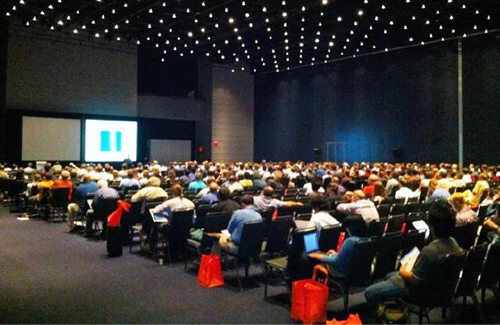 |
| Dr. Carson Chow on The Dynamics of Obesity [Photo credit: Nick Higham] |
In an invited presentation, Dr. Carson Chow of the NIH, a joint speaker at Annual Meeting and the SIAM Conference on the Life Sciences, gave a very engaging account of “The Dynamics of Obesity” from a mathematical standpoint. Explaining weight change in the human body as simply the difference between the rate of food intake and energy expenditure, Dr. Chow went on to explain the various other factors that influence obesity. Weight gain depends not only on the energy density of the various components of the body, such as water, bones, minerals, fat, protein and carbohydrates, but also on the fuel source or macronutrients—in laymen’s terms—fat, carbs and protein. He explained the significance of this research with a scary statistic: the average body weight of Americans has increased linearly since the mid seventies; at the same time, the percentage of obese people has gone up dramatically. Based on applying his mathematical model to the US population, Chow concluded that the reason for this weight gain is simply the “food push” in the country. The amount of food available per capita in the U.S. is much too high, and this needs to be combated for a long-term solution to the obesity epidemic.
Read a detailed summary of the talk on his blog here: http://sciencehouse.wordpress.com/2010/07/23/summary-of-siam-talk/#more-1313
Slides from his talk can also be viewed on his blog here: http://sciencehouse.wordpress.com/2010/07/12/siam-talk/
Stirring tails of evolution
| ‘Stirring Tails of Evolution’ by Dr. Raymond Goldstein [Photo credit: Karthika Muthukumaraswamy] |
Dr. Raymond Goldstein of the University of Cambridge, in his invited lecture at the SIAM Conference on the Life Sciences, traced the evolutionary transition of organisms from single cells to multicellular species in his talk, “Stirring tails of evolution.” Dr. Goldstein explained that the processes of transport and locomotion, triggered by the need for efficient chemical exchange between an organism and its environment, were the driving forces for this transition to multicellularity through evolution. From the windowed Fourier transform of the beating flagella of the single-celled Chlamydomonas, which explains its swimming pattern, to the mathematics of turning that guides the multicellular Volvox toward light without the need for a central nervous system, Dr. Goldstein gave various examples, proving that “nature really is a mathematician.”
Mathematics, Industry and AN10
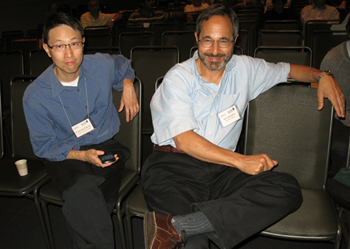 |
| Math in Industry panelists Carson Chow & Robert Schreiber [Photo credit: Susan Whitehouse] |
With applied mathematics gaining rapid significance in the industrial sector, the “Evolution of Math in Industry” panel at AN10 addressed the timely topic of the increasing prominence of applied mathematics in interdisciplinary degrees, and the consequences of such a shift.
Panelists expressed their viewpoints and entertained audience questions. Robert Schreiber of Hewlett-Packard observed that applied mathematicians, while not a distinct group, are absorbed by different fields. Jim Morel of Texas A&M University noted that from the changes he had witnessed in computational mathematics and engineering education, multidisciplinary education was certainly growing, and had a positive effect on the field. The NIH’s Carson Chow observed that as the mathematical field matures, it is but natural for it to intersect with other areas. However, mathematicians will always remain distinct, he said. Pavel Bochev of Sandia National Laboratories echoed this point, viewing the current trend as a “technology transfer cycle” where mature applied math tools are adopted by science and engineering disciplines that drove their development. “It’s a natural process when a science matures,” Bochev said. “It sheds certain elements from its core, and leaves room for new development.”
Applying mathematics to industry
Several invited presentations at AN10 explored the application of mathematics in industry.
Dr. Charles Wampler of General Motors Research, in his talk, “Kinematics and Numerical Algebraic Geometry,” explained the application of numerical algebraic geometric concepts to solve kinematics for the design and control of mechanical devices, such as robots.
Dr. Clas Jacobson of United Technologies Corporation gave an overview of the role of mathematics and computational science in delivering low-energy and cost-effective solutions for greener buildings in his talk, “Energy Efficiency in the Built Environment.” His research focuses on optimizing building design and operation to help improve their efficiency as whole systems. Watch a video interview with the speaker:
Alex Bangs of Entelos, Inc., in his talk, “From Targets to Populations to Individuals,” described new technologies that are being developed to combat the high failure rate of pharmaceutical clinical studies. Virtual patients that simulate the behavior of a drug in the body allow for the analysis of target molecules and therapeutic responses. In addition, they are data mined to identify biomarkers for patient response or non-response. Watch a video interview with the speaker:
Prizes & Awards Luncheon
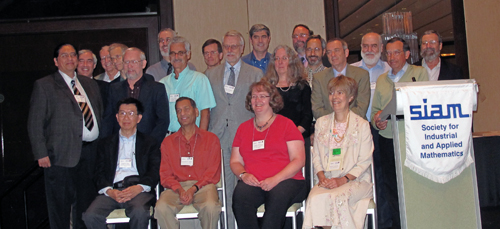 |
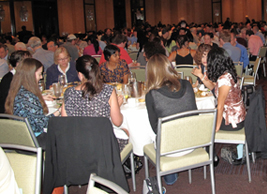 |
| Fellows recognized at AN10 [Photo credit: Susan Whitehouse] | Attendees enjoying the Awards luncheon [Photo credit: Susan Whitehouse] |
Go to http://www.siam.org/prizes/2010_luncheon.php for further information on prizes and prize recipients.
In addition, individuals selected to the 2010 Class of Fellows earlier this year for their exemplary contributions to the fields of applied mathematics and computational science were recognized. For more information, visit on the Fellows page: http://fellows.siam.org/index.php?sort=year&value=2010
SIAM AN10 Exhibits
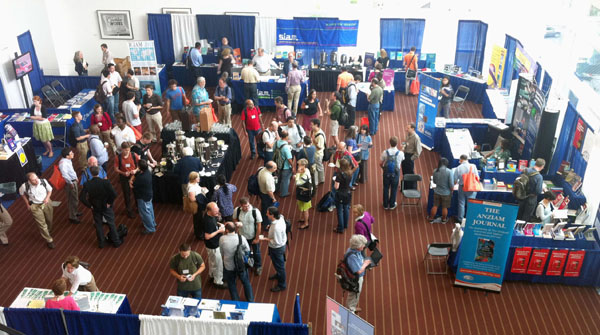 |
| SIAM Annual Meeting exhibit area [Photo credit: Nick Higham] |
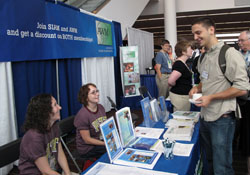 |
| University of Pittsburgh volunteers help out at the SIAM Membership Booth [Photos credit: Susan Whitehouse] |
Several organizations and institutions exhibited at the 2010 Annual Meeting: AMS, Cambridge University Press, Taylor & Francis, National Institute of Biomedical Imaging and Bioengineering, Springer, Birkhauser, The MathWorks, EDP Sciences, Salford Systems, Royal Society/Tou-Can Marketing, USC Epstein, John Wiley & Sons, Oxford University Press, Princeton University Press, AWM, IOS Press, International Press, American Institute of Physics, Springer, IBM Research, and SIAM Membership.
The SIAM membership booth catered to current and prospective members, and the SIAM Books booth boasted an impressive collection covering a wide range of subjects from applied mathematics and computational science. Attendees and members were given discounts on prices. Toward the end of the meeting, books were given away to students at the Student Book Giveaway.
Student Prize Winners and Presentations
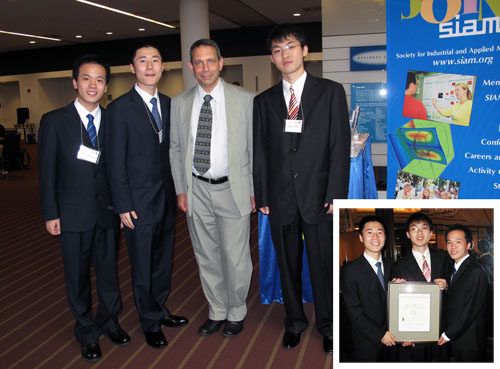 |
| MCM Award winners from HUST, China with SIAM President Doug Arnold |
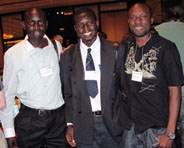 |
Student Paper Prize Winner Bubacarr Bah (University of Edinburgh) with student chapter members, Abdoul Aziz and Ibrahim Diakite [Photo Credit: Susan Whitehouse] |
Several student prizes were awarded at the Prizes and Awards Luncheon at AN10. The students presented their winning papers at the Student Prize Winner Presentations.
The team from Huazhong University of Science and Technology (HUST) in Wuhan, China, who won The SIAM Award in the Mathematical Contest in Modeling for the “continuous” category, presented their analysis of the discrepancy between empirical observation and torque theory in the location of the "sweet spot" on a baseball bat – the point where the bat makes contact with a ball for maximum power. The team from Rensselaer Polytechnic Institute in Troy, New York, took turns to explain their model to determine criminal activity, based on a criminal’s geographical profile and past patterns. Using probability distributions to define crime scenes to factoring in kill distributions, they explained their model with selected case studies.
MCM winners from RPI, NY present their paper [Photo Credit: Karthika Muthukumaraswamy] |
In presenting his paper, "Improved Restricted Isometry Constant Bounds for Gaussian Matrices,” Bubacarr Bah of the University of Edinburgh explored a relatively new area of random matrix theory, providing a derivation for the smallest known bounds on Restricted Isometry Constants for large rectangular matrices. Rice University’s Russell Carden presented his paper, "A Simple Algorithm for the Inverse Field of Values Problem," elaborating on his research on the structure of the field of values associated with matrices. Karin Leiderman of the University of Utah presented her model of the spatial-temporal growth of a thrombus along the wall and within the lumen of a blood vessel, while presenting her paper, "Grow with the Flow: A Spatial-Temporal Model of Platelet Deposition and Blood Coagulation under Flow.”
| www.flickr.com |
Check out the entire SIAM AN10/LS10 Photoset.

